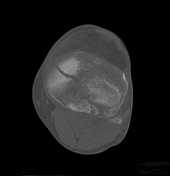Schatzker classification of tibial plateau fractures
Updates to Article Attributes
Body
was changed:
The Schatzker classification system is one method of classifying tibial plateau fractures and splits the fracture into six types. In the Schatzker classification, each increasing numeric fracture category indicates increasing severity, reflecting not only increased energy imparted to the bone at the time of injury but also an increasingly worse prognosis1.
The most common fracture of the tibial plateau, is type II.
This system divides tibial plateau fractures into six types:
- Schatzker I - is a wedge-shaped pure cleavage fracture of the lateral tibial plateau, originally defined as having less than 4 mm of depression or displacement.
- Schatzker II - split and depression of the lateral tibial plateau - type I fracture with a depressed component.
-
Schatzker III - pure depression of the lateral tibial plateau.
- divided into two subtypes
- Schatzker IIIa - those with lateral depression
- Schatzker IIIb - those with central depression
- divided into two subtypes
- Schatzker IV - pure depression of the medial tibial plateau, without a fracture fragment.
-
Schatzker V -
a bicondylar fractureinvolving both tibial plateau. - Schatzker VI - fracture through the metadiaphysis of the tibia.
Etymology
It was first published by Joseph Schazker et.al, in 1990 4
See also
-<p>The <strong>Schatzker classification</strong> system is one method of classifying <a title="tibial plateau fractures" href="/articles/tibial-plateau-fracture">tibial plateau fractures</a> and splits the fracture into six types. In the Schatzker classification, each increasing numeric fracture category indicates increasing severity, reflecting not only increased energy imparted to the bone at the time of injury but also an increasingly worse prognosis<sup>1</sup>.</p><p>The most common fracture of the tibial plateau, is type II.</p><p>This system divides tibial plateau fractures into six types: </p><ul>-<li>-<strong>Schatzker I -</strong> is a wedge-shaped pure cleavage fracture of the lateral tibial plateau, originally defined as having less than 4 mm of depression or displacement.</li>-<li>-<strong>Schatzker II -</strong> split and depression of the lateral tibial plateau - type I fracture with a depressed component.</li>-<li>-<strong>Schatzker III -</strong> pure depression of the lateral tibial plateau.-<ul><li>divided into two subtypes-<ul>-<li>-<strong>Schatzker IIIa</strong> - those with lateral depression</li>-<li>-<strong>Schatzker IIIb</strong> - those with central depression</li>- +<p>The <strong>Schatzker classification</strong> system is one method of classifying <a href="/articles/tibial-plateau-fracture">tibial plateau fractures</a> and splits the fracture into six types. In the Schatzker classification, each increasing numeric fracture category indicates increasing severity, reflecting not only increased energy imparted to the bone at the time of injury but also an increasingly worse prognosis<sup>1</sup>.</p><p>The most common fracture of the tibial plateau, is type II.</p><p>This system divides tibial plateau fractures into six types: </p><ul>
- +<li>
- +<strong>Schatzker I</strong> - is a wedge-shaped pure cleavage fracture of the lateral tibial plateau, originally defined as having less than 4 mm of depression or displacement.</li>
- +<li>
- +<strong>Schatzker II</strong> - split and depression of the lateral tibial plateau - type I fracture with a depressed component.</li>
- +<li>
- +<strong>Schatzker III</strong> - pure depression of the lateral tibial plateau.<ul><li>divided into two subtypes<ul>
- +<li>
- +<strong>Schatzker IIIa</strong> - those with lateral depression</li>
- +<li>
- +<strong>Schatzker IIIb</strong> - those with central depression</li>
-</li>-<li>-<strong>Schatzker IV -</strong> pure depression of the medial tibial plateau, without a fracture fragment.</li>-<li>-<strong>Schatzker V -</strong> a bicondylar fracture.</li>-<li>-<strong>Schatzker VI -</strong> fracture through the metadiaphysis of the tibia. </li>-</ul><h4>Etymology</h4><p>It was first published by <strong>Joseph Schazker </strong>et.al, in 1990 <sup>4</sup> </p><h4>See also</h4><ul><li><a title="Eponymous fractures" href="/articles/eponymous-fractures">eponymous fractures</a></li></ul>- +</li>
- +<li>
- +<strong>Schatzker IV -</strong> pure depression of the medial tibial plateau, without a fracture fragment.</li>
- +<li>
- +<strong>Schatzker V -</strong> involving both tibial plateau.</li>
- +<li>
- +<strong>Schatzker VI -</strong> fracture through the metadiaphysis of the tibia. </li>
- +</ul><h4>Etymology</h4><p>It was first published by <strong>Joseph Schazker </strong>et.al, in 1990 <sup>4</sup> </p><h4>See also</h4><ul><li><a href="/articles/eponymous-fractures">eponymous fractures</a></li></ul>
References changed:
- 1. Markhardt B, Gross J, Monu J. Schatzker Classification of Tibial Plateau Fractures: Use of CT and MR Imaging Improves Assessment1. Radiographics. 2009;29 (2): 585-597. <a href="http://radiographics.rsna.org/content/29/2/585.full">Radiographics (full text)</a> - <a href="http://dx.doi.org/10.1148/rg.292085078">doi:10.1148/rg.292085078</a><span class="ref_v3"></span>
- 1. Markhardt BK, Gross JM, Monu JU. Schatzker classification of tibial plateau fractures: use of CT and MR imaging improves assessment. Radiographics. 29 (2): 585-97. <a href="http://dx.doi.org/10.1148/rg.292085078">doi:10.1148/rg.292085078</a> [<a href="http://www.ncbi.nlm.nih.gov/pubmed/19325067">pubmed citation</a>]
Images Changes:
Image ( update )
Caption
was changed:
Case 2 -: type II
Image ( update )
Caption
was changed:
Case 3 -: type II
Image ( update )
Caption
was changed:
Case 3 -: type II
Image ( update )
Caption
was changed:
Case 9 -: type II
Image 6 CT (bone window) ( update )

Caption
was changed:
Case 1 -: type II
Image 16 CT (bone window) ( update )

Caption
was changed:
Case 6 -: type IIIb
Image 19 CT (bone window) ( update )

Caption
was changed:
Case 10 -: type V







 Unable to process the form. Check for errors and try again.
Unable to process the form. Check for errors and try again.